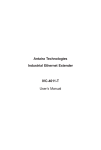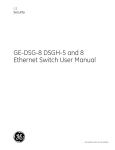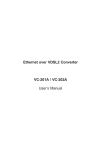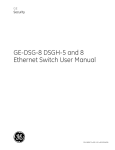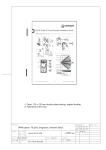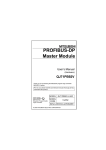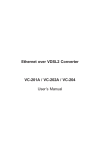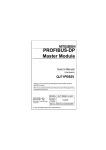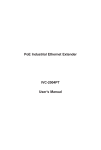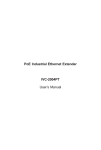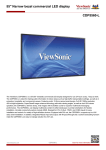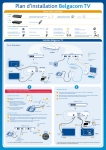Download IFS MC250-4T/1CXT User Manual
Transcript
IFS MC250-4T/1CXT User Manual P/N 1076521 • REV A • ISS 30APR12 Copyright Trademarks and patents Manufacturer EU Version Certification FCC compliance Canada © 2012 UTC Fire & Security Company. All rights reserved. Interlogix, IFS MC250-4T/1CXT, the IFS Brand and logo are trademarks of UTC Fire & Security. Other trade names used in this document may be trademarks or registered trademarks of the manufacturers or vendors of the respective products. UTC Fire & Security Americas Corporation, Inc. 2955 Red Hill Avenue, Costa Mesa, CA 92626-5923, USA Authorized EU manufacturing representative: UTC Fire & Security B.V. Kelvinstraat 7, 6003 DH Weert, Netherlands This document applies to IFS MC250-4T/1CXT version 1.0. N4131 Class A: This equipment has been tested and found to comply with the limits for a Class A digital device, pursuant to part 15 of the FCC Rules. These limits are designed to provide reasonable protection against harmful interference when the equipment is operated in a commercial environment. This equipment generates, uses, and can radiate radio frequency energy and, if not installed and used in accordance with the instruction manual, may cause harmful interference to radio communications. Operation of this equipment in a residential area is likely to cause harmful interference in which case the user will be required to correct the interference at his own expense. This Class A digital apparatus complies with Canadian ICES-003. Cet appareil numérique de la classe A est conforme à la norme NMB-003 du Canada. ACMA compliance Notice! This is a Class A product. In a domestic environment this product may cause radio interference in which case the user may be required to take adequate measures. European Union directives 2004/108/EC (EMC directive): Hereby, UTC Fire & Security declares that this device is in compliance with the essential requirements and other relevant provisions of Directive 2004/108/EC 2002/96/EC (WEEE directive): Products marked with this symbol cannot be disposed of as unsorted municipal waste in the European Union. For proper recycling, return this product to your local supplier upon the purchase of equivalent new equipment, or dispose of it at designated collection points. For more information see: www.recyclethis.info. Contact information Customer support www.utcfireandsecurity.com or www.interlogix.com www.interlogix.com/customer-support Contents Overview 1 Package Contents 1 Ethernet over VDSL2 Bridge Description 1 Key Features 3 Hardware Overview 4 LED Indicators 5 System 5 VDSL/BNC 5 10/100Base-TX Port 5 Mode DIP Switch 5 The Top Panel 7 Installation 8 Installing the MC250-4T/1CXT 8 MC250-4T/1CXT Application Connection 9 Wiring the Power Inputs 9 Wiring the Fault Alarm Contact 10 Mounting Installation 11 Troubleshooting 15 FAQs 16 Specifications 18 Contacting Technical Support 19 IFS MC250-4T/1CXT User Manual i Overview Package Contents Before installing the IFS MC250-4T/1CXT Industrial Ethernet Converter, verify that package contains the following parts: • IFS MC250-4T/1CXT x1 • DIN Rail Kit x1 • Wall Mount Kit x1 • User’s Manual x1 If any of the items in the package are damaged or missing, please contact your distributor or IFS sales rep. If possible, retain the original carton and packaging material in case of need to return the product for repair/replacement. Ethernet over VDSL2 Bridge Description IFS’s state-of-the-art Ethernet-over-VDSL2 products are based on two core networking technologies: Ethernet and VDSL2 (Very-high-data-rate Digital Subscriber Line 2). This technology offers the absolute fastest possible data transmission speeds over existing copper telephone lines or coaxial cables without the need for rewiring. The IFS MC250-4T/1CXT Industrial Ethernet Converter has a switching architecture with 4 RJ-45 10/100Mbps Ethernet ports and one asymmetric or symmetric Ethernet over VDSL port (Asymmetric means upstream and downstream rate are not the same and Symmetric means upstream and downstream rate are similar) – the VDSL port can be RJ-11or BNC Connector. The MC250-4T/1CXT can be set to Master or Slave mode via a DIP switch. The MC250-4T/1CXT coax symmetric data rate performance will be 95/99Mbps for at 200m, and 19/13Mbps at IFS MC250-4T/1CXT User Manual 1 2400m. The MC250-4T/1CXT (BNC) coax performance is up to 100/65Mbps for asymmetric data rate within 200m and 31/4Mbps for asymmetric data rate at 2.4km. The IFS MC250-4T/1CXT Industrial Ethernet Converter is engineered in a slim metal enclosure that conforms to IP30 standards for deployment in demanding industrial environments. The IFS MC250-4T/1CXT provides a lower cost replacement and smooth migration for existing Long Reach Ethernet (LRE) networks. The cable specifications of the connection are listed as following: • 10Base-T, Category 3, 4 or 5 UTP • 100Base-TX, Category 5, 5e or 6 UTP • Ethernet over VDSL2, Twisted-pair Telephone Wires • Ethernet over VDSL2 Coaxial Cable Note: Slave devices (CPE) must connect to the Master device (CO) through the telephone wire or coaxial cable. To define the MC250-4T/1CXT as a Master or Slave, please refer to the Mode DIP Switch section for more detail. 2 IFS MC250-4T/1CXT User Manual Key Features The MC250-4T/1CXT provides the following key features: • Cost-effective VDSL2 Master / Slave bridge solution • -40º to 75º Degree C operating temperature • Redundant Power Design: 12~48V DC, redundant power with polarity reverse protect function • IP-30 metal case • One box design, Master / Slave selectable via DIP Switch • Defines Asymmetric (Band Plan 998) and Symmetric band plans for the transmission of Upstream and Downstream signals • Complies with IEEE 802.3, IEEE 802.3u and IEEE 802.3x standards • DMT (Discrete Multi-Tone) line coding • Half Duplex Back Pressure and IEEE 802.3x Full Duplex Pause Frame Flow Control • Support up to 1536 bytes packet size, 802.1Q VLAN tag transparent • Integrated address look-up engine, support 2K absolute MAC addresses • VDSL2 Stand-Alone transceiver for simple bridge modem application • Selectable Target Band Plan and Target SNR Margin • LED indicators for network diagnostics • DIN Rail and Wall Mount Design IFS MC250-4T/1CXT User Manual 3 Hardware Overview The MC250-4T/1CXT provides 4 10/100 Mbps RJ-45, 1 RJ-11 and 1 BNC port for network line connection. The 4 RJ-45 ports will distinguish the speed of incoming connection automatically. This section describes the hardware features of the MC2504T/1CXT. For easier control of the MC250-4T/1CXT, it's recommended to get familiar with the LED indicators and port characteristics. Front panel illustrations in this chapter display the units LED indicators. Before connecting any network device to the MC250-4T/1CXT, read this chapter carefully. Figure 1: Front Panel 4 IFS MC250-4T/1CXT User Manual LED Indicators System LED P1 P2 FAULT Color Function Green Light Green Light Green Light Indicates that the power is active. indicates power 2 is active. indicates that either power 1 or power 2 does not have power. VDSL/BNC LED Color ACT Green Sync Green Function Light Indicates that the VDSL link is established. Indicates that the VDSL link is actively sending or Blink receiving data over that port. Light Indicates that the VDSL link is established. Fast Blink Slow Blink Indicates that the VDSL link is at training status (about 10 seconds). Indicates that the VDSL link is at idle status. Master Green Light Slave Light Green Indicates that the VDSL Bridge is running in Master mode. Indicates that the VDSL Bridge is running in Slave mode. 10/100Base-TX Port LED Color LNK/ ACT Green Function Light Indicates that the port is link up. Indicates that the Converter is actively sending or Blink receiving data over that port. Off Indicates that the port is link down. Mode DIP Switch The MC250-4T/1CXT provides 4 selective transmission modes. By switching the transmission modes, you can obtain a best transmission mode to suit the phone line quality or IFS MC250-4T/1CXT User Manual 5 distance of connectivity. The following is a summary table of transmission settings, bandwidth and distance extensibility tested for AWG 24 (0.5mm) twisted-pair without noise and cross talk. DIP-1 DIP-2 DIP-3 DIP-4 Mode Channel Band Plan SNR OFF Master Interleave Symm 9dB ON (default) Slave Fast Asymm 6dB Master / Slave • Master (Central Office) – in Master device mode, usually the Master device will be located at the data center of the ISP or enterprise to link to the backbone. For IP video applications, the Master (CO) setting should be used at the IP camera for maximum bandwidth availability over distance. • Slave (Customer Premises Equipment) – the Slave device mode, usually the Slave device will be located at branch office, home or remote side as the long reach data receiver. The Slave also can be connected to the network devices such as a PC, VoIP, Wireless Access Point, etc. When the MC250-4T/1CXT is operating in Slave mode, the DIP switch 2, 3, and 4 are disabled. Fast and Interleave mode • 6 Fast mode guarantees a minimum end to end latency of less than 1 ms. IFS MC250-4T/1CXT User Manual • Interleaved mode provides impulse noises protection with a duration of less than 250 µs. Interleaved mode has a maximum end to end latency of 10m sec. Band Plan • User can switch the Band Plan to either Symmetric or Asymmetric based on the application. Symmetric band plan provides better upstream performance while Asymmetric band plan provides a better downstream performance. Target SNR (Signal Noise Ratio) Margin • When fixed SNR margin is selected, the system will maintain the SNR margin at 9 dB across all usable loop length. Note: The default for the DIP switch settings is "ON" for all four switches, that sets the media converter to CPE mode. For selecting "CO" mode, please adjust the DIP 1 switch to "OFF". Please power off the MC250-4T/1CXT before making any transmission mode adjustments. The Top Panel The top panel of the MC250-4T/1CXT consists of a terminal block connector with two DC power inputs. Figure 2 shows the top panel of the MC250-4T/1CXT. IFS MC250-4T/1CXT User Manual 7 Figure 2: Top Panel Installation Installing the MC250-4T/1CXT The MC250-4T/1CXT does not require any software configuration. Users can immediately use any feature of this product simply by attaching the cables and power plug. There is some key limitation on the MC250-4T/1CXT. Please check the following items: MC250-4T/1CXT: The device is used for Point-to-Point connection only (Master device to Slave device) and is equipped with one RJ-11 and one BNC connectors for VDSL2 port for network link connection. Phone wire: Depending on the quality of the telephone line being used, the maximum distance of one VDSL segment is 1.6km (5249ft) with AWG 24 telephone wires. Coaxial: Depending on the quality of the coaxial cable being used, the maximum distance of one VDSL segment is 3.0km (9842ft) with 50 or 75 ohm coaxial cable. The distance achieved will vary according to the quality of telephone wires and coaxial cables. 8 IFS MC250-4T/1CXT User Manual MC250-4T/1CXT Application Connection Two sets of the MC250-4T/1CXTs could be used to link two local Area networks that are located in different locations. Through a normal telephone line or coaxial cable, 100/55Mbps (RJ-11) or 100/65Mbps (BNC) asymmetric backbone, can be setup with one media converter in Master (CO) mode and the other in Slave (CPE) mode. Figure 3: MC250-4T/1CXT VDSL2 (RJ-11) connection Figure 4: MC250-4T/1CXT VDSL2 (BNC) connection Wiring the Power Inputs The 6-contact terminal block connector on the top panel of the MC250-4T/1CXT is used for two DC redundant powers inputs. Please follow the steps below to insert the power wires. 1. Insert positive / negative DC power wires into the contacts 1 and 2 for POWER 1, or 5 and 6 for POWER 2. IFS MC250-4T/1CXT User Manual 9 V1- V1+ V2- V2+ 2. Tighten the wire-clamp screws to prevent the wires from disconnecting. 1 - 2 Power 1 + 3 4 5 Fault 6 Power 2 - + Wiring the Fault Alarm Contact The fault alarm contacts are in the middle of the terminal block connector as the picture shows below. Inserting the wires, the MC250-4T/1CXT will detect the fault status of the power failure and then forms an open circuit. The following illustration shows an application example for wiring the fault alarm contacts. 10 IFS MC250-4T/1CXT User Manual 1 2 3 4 5 6 Insert the wires into the fault alarm contacts Note: The wire gauge for the terminal block should be in the range between 12 ~ 24 AWG. The alarm relay circuit accepts up to 30V, max. 3A currents. Mounting Installation This section describes how to mount the MC250-4T/1CXT and make connections to it. Please read the following sections and perform the procedures in the order presented. Note: In the installation steps below, this Manual uses the GEDSGH-8 (IFS 8 Port Industrial Gigabit Switch) as an example. However, the steps for any IFS Industrial Switch & Industrial Media Converter are similar. IFS MC250-4T/1CXT User Manual 11 Mounting to a DIN-Rail The DIN-Rail kit comes assembled on the MC250-4T/1CXT out of the box. Please refer to following figures to hang the MC250-4T/1CXT on a DIN-Rail. 1. Lightly press the bottom of the DIN-Rail connector mount into the track. 12 IFS MC250-4T/1CXT User Manual 2. Check that the DIN-Rail connector mount is tightly mounted on the track. 3. Please refer to following procedures to remove the MC2504T/1CXT from the track. 4. Lightly press the bottom of DIN-Rail connector mount to remove it from the track. Mounting to a Wall To install the MC250-4T/1CXT on the wall, please follows the instructions described below. 1. Loosen the screws to remove the DIN Rail from the Media Converter. IFS MC250-4T/1CXT User Manual 13 2. Place the wall mount plate on the rear panel of the MC2504T/1CXT. 3. Assemble the wall mount plate on the MC250-4T/1CXT. 4. Use the hook holes at the corners of the wall mount plate to hang the MC250-4T/1CXT on the wall. 14 IFS MC250-4T/1CXT User Manual Troubleshooting SYMPTOM: VDSL LNK LED does not light after wire is connected to the VDSL port. CHECKPOINT: • Verify that the length of the wire connected between two MC250-4T/1CXT is not more than 2.4km. Please also try to adjust the DIP switch of MC250-4T/1CXT to other SNR mode. • Please note you must use one MC250-4T/1CXT with Master mode and the other MC250-4T/1CXT with Slave mode. SYMPTOM: TP LED does not illuminate after the cable is connected to the port. CHECKPOINT: • Verify that you are using the Cat.5, 5e or 6 cables with RJ45 connector to connect to the port. • If your device (i.e. LAN card) supports Auto-Negotiation, try to set it to a fixed speed manually. • Make sure that both converter and the connected devices are turned on. • Make sure that all cables are properly plugged in to the correct ports. • Make sure that the cable is not bad. • Make sure that the power adapters are functional for each device. IFS MC250-4T/1CXT User Manual 15 FAQs Q1: What is the voltage and current rating to power MC2504T/1CXT media converter? A1: 12 ~ 48V DC Q2: What is VDSL2? A2: VDSL2 (Very High-Bit-Rate Digital Subscriber Line 2), G.993.2 is the newest and most advanced standard of xDSL broadband wire line communications. Designed to support the wide deployment of Triple Play services such as voice, data, high definition television (HDTV) and interactive gaming, VDSL2 enable operators and carrier to gradually, flexibly, and cost efficiently upgrade exiting xDSLinfrastructure. Q3: What distances can be achieved between MC250-4T/1CXT media converters? A3: Under ideal conditions and use of quality cable maximum distances of 1.4 km for telephone wire (POTS) or 2.4km for coax cable can be achieved. Q4: What is the maximum date rate for MC250-4T/1CXT? A4: Under ideal conditions and use of quality cable maximum distances: 200 meters, 99Mbps/63Mbps (downstream/upstream) for telephone cable or 100Mbps/65Mbps (downstream/upstream) for coax cable. Q5: What is SNR and what’s the effect? A5: In analog and digital communications, Signal-to-Noise Ratio, often written SNR, is a measure of signal strength 16 IFS MC250-4T/1CXT User Manual relative to background noise. The ratio is usually measured in decibels (dB). In digital communications, the SNR will probably cause a reduction in data speed because of frequent errors that require the source (transmitting) computer or terminal to resend some packets of data. SNR measures the quality of a transmission channel over a network channel. The greater the ratio, the easier it is to identify and subsequently isolate and eliminate the source of noise. Generally speaking, the higher SNR value gets better line quality, but lower performance. Q6: What is band plan and what’s the effect? A6: VDSL2 defines multiple band plans and configuration modes (profiles) to allow asymmetric and symmetric services in the same binder (by designated frequency bands) for the transmission of upstream and downstream signals. User has the ability to select fixed band plan. Symmetric band plan provides better downstream performance while Asymmetric band plan provides better upstream performance. IFS MC250-4T/1CXT User Manual 17 Specifications Ethernet Description Data Rate 10/100Bast-TX with Auto-negotiate and Auto-MDI/MDI-X Connectors 4-RJ-45 Cable 10 Base-T (Cat 3, 4, 5) / 100Base-TX T (Cat 5, 5e, 6) - 328ft (100m) VDSL2 VDSL2 Transmission Mode VDSL-DMT Encoding Telephone cable CO/CPE Mode; Channel; Rate Limit; SNR ITU-T G.993.1 VDSL; ITU-T G.997.1; ITU-T G.993.2 VDSL2 (Profile 17a support) 24AWG or better Phone Line connector 1-RJ-11 female Coaxial Cable 50 or 75 ohm coax Coax Connector 1-BNC female VDSL2 Distance > Data Rate Distance 656 ft. (200m) 1,312 ft. (400m) 1,969 ft. (600m) 2,525 ft. (800m) 3,281 ft. (1000m) 3,937 ft. (1200m) 4,593 ft. (1400m) 5,249 ft. (1600m) 5,906 ft. (1800m) 6,562 ft. (2000m) 7,218 ft. (2200m) 7,874 ft. (2400m) Down Stream / Up Stream Asymmetric Symmetric Twisted-Pr 99/63 Mbps 91/48 Mbps 71/32 Mbps 53/18 Mbps 38/8 Mbps 33/5 Mbps 28/2 Mbps ------ Coax 99/65 Mbps 99/64 Mbps 97/59 Mbps 94/51 Mbps 84/45 Mbps 73/37 Mbps 62/28 Mbps 54/20 Mbps 48/13 Mbps 38/9 Mbps 35/6 Mbps 31/4 Mbps Twisted-Pr 91/99 Mbps 74/79 Mbps 54/51 Mbps 38/34 Mbps 27/21 Mbps 24/15 Mbps 21/10 Mbps ------ Coax 95/99 Mbps 92/97 Mbps 81/82 Mbps 71/70 Mbps 60/57 Mbps 50/44 Mbps 42/33 Mbps 37/27 Mbps 29/22 Mbps 23/21 Mbps 19/17 Mbps 19/13 Mbps LED Indicators Power P1: On - Green; P2: On - Green; FAULT: Green 10/100 Base-TX Port LNK/ACT; 100Mbps - Green VDSL2 Port LNK/ACT; CO Mode; CPE Mode; Sync. (Green) Electrical and Mechanical Power 12VDC ~ 48VDC Enclosure IP-30 Rated Metal Dimensions (H x W x D) 5.3 x 3.5 x 1.26 in. (135 x 87.8 x 32 mm) Weight 0.3 lbs. / 83g Environmental Operating Temperature -40ºC ~ +75ºC Storage Temperature -40ºC ~ +85ºC Relative Humidity 0%–90% (non-condensing) 18 IFS MC250-4T/1CXT User Manual Contacting Technical Support Contact technical support if you encounter any difficulties during this installation. Please make sure you have the requested diagnostic or log files ready before you contact us by phone or go to www.interlogix.com/customer-support. Technical Support Europe, Middle East and Africa W Select Contact Us at www.utcfssecurityproducts.eu North America T +1 855.286.8889 E [email protected] Australia E [email protected] IFS MC250-4T/1CXT User Manual 19




























